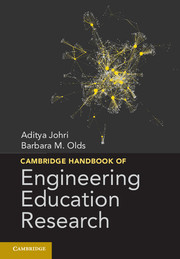Book contents
- Frontmatter
- Dedication
- Contents
- Editors
- Contributors
- Foreword
- Acknowledgments
- Introduction
- Chapter 1 Chronological and Ontological Development of Engineering Education as a Field of Scientific Inquiry
- Part 1 Engineering Thinking and Knowing
- Part 2 Engineering Learning Mechanisms and Approaches
- Chapter 8 Problem-Based and Project-Based Learning in Engineering Education
- Chapter 9 Case Studies in Engineering
- Chapter 10 Curriculum Design in the Middle Years
- Chapter 11 Engineering Design Education
- Chapter 12 Adaptive Expertise and Knowledge Fluency in Design and Innovation
- Chapter 13 Learning Disciplinary Ideas and Practices Through Engineering Design
- Part 3 Pathways into Diversity and Inclusiveness
- Part 4 Engineering Education and Institutional Practices
- Part 5 Research Methods and Assessment
- Part 6 Cross-Cutting Issues and Perspectives
- Index
- References
Chapter 13 - Learning Disciplinary Ideas and Practices Through Engineering Design
Published online by Cambridge University Press: 05 February 2015
- Frontmatter
- Dedication
- Contents
- Editors
- Contributors
- Foreword
- Acknowledgments
- Introduction
- Chapter 1 Chronological and Ontological Development of Engineering Education as a Field of Scientific Inquiry
- Part 1 Engineering Thinking and Knowing
- Part 2 Engineering Learning Mechanisms and Approaches
- Chapter 8 Problem-Based and Project-Based Learning in Engineering Education
- Chapter 9 Case Studies in Engineering
- Chapter 10 Curriculum Design in the Middle Years
- Chapter 11 Engineering Design Education
- Chapter 12 Adaptive Expertise and Knowledge Fluency in Design and Innovation
- Chapter 13 Learning Disciplinary Ideas and Practices Through Engineering Design
- Part 3 Pathways into Diversity and Inclusiveness
- Part 4 Engineering Education and Institutional Practices
- Part 5 Research Methods and Assessment
- Part 6 Cross-Cutting Issues and Perspectives
- Index
- References
Summary
Introduction
When pre-college students are given opportunities to engage in engineering, and those opportunities are carefully structured to include particular affordances, much more than designing and building can take place. Engineering education researchers who focus on elementary and secondary education are finding that engineering design can help create an environment for the learning of ideas and practices in a variety of academic disciplines. In this chapter, we put forth a framework, case-based reasoning, that suggests ways of carefully conceiving engineering design activities to support disciplinary learning. We highlight K–12 engineering education research that exemplifies the structures and practices suggested by the case-based reasoning framework. These research studies inform our understanding of how students learn disciplinary ideas and practices through engineering design at the pre-college level.
For a first glimpse into this work, picture the following scene in a third-grade science classroom. Two students are consulting with their teacher about the final assignment of their musical instrument engineering unit. The goal is a novel instrument that can play three different pitches. After a brief discussion to help the students see the strengths and weaknesses of their initial plan, the teacher sends them on their way to revise their ideas.
- Type
- Chapter
- Information
- Cambridge Handbook of Engineering Education Research , pp. 243 - 264Publisher: Cambridge University PressPrint publication year: 2014
References
- 8
- Cited by

